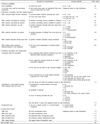Abstract
BACKGROUND/OBJECTIVES
SUBJECTS/METHODS
RESULTS
CONCLUSIONS
Figures and Tables
 | Fig. 2Conceptual framework for measuring the school nutrition environment with links to students' eating patterns and body weight status in South Korea |
Table 1
Participating schools' characteristics in measuring school nutrition environments in South Korea

Table 2
Measured aspects of school nutrition environments in South Korea

1)In the bivariate and multivariate analyses, a composite variable was created based on these 7 items by giving 1 to “offer” responses and 0 to “do not offer” responses. A binary variable was created: ‘good’ vs. ‘bad’ based on the mean of the composite scores from the sample.
2)Consists of four items: perceived importance of school-based health promotion (0: not so important, 1: somewhat important, but not urgent, 2: very important, but hard to implement, 3: very important, now implementing); perception of cooperation between teachers (0: very hard to work with other teachers for health programs, 1: somewhat hard to work with, 2: easy to work with, 3: very easy to work with); perception of principal's support (0: not supportive at all, 1: not supportive, 2: somewhat supportive, 3: very supportive); perception of budget accessibility (0: very hard to get necessary budget for health programs, 1: hard to get, 2: somewhat easy to get, 3: very easy to get).
3)Since all schools had a different total number of meals offered during the same period of two months, the percentage of meals that offered certain food items or used certain cooking methods in the total number of meals was calculated. During analyses, categorical variables for each item were utilized due to the discontinuous nature of the data (low, mid, and high percentage of offering).
Table 3
Creating a school nutrition-environment index in South Korea

1)Cutoffs are based on data distribution in the current survey
2)Calculated based on school lunch documents (lunch menus for a 2-month period) collected from participating schools
3)In the multivariate analyses, a categorical variable was used (3 categories based on the total score): score range, 17-28
Reprinted from Park S, Choi BY, Wang Y, Colantuoni E, and Gittelsohn J. School and neighborhood nutrition environment and their association with students' nutrition behaviors and weight status in Seoul, South Korea. J Adolesc Health. 2013;53(5):655-62, with permission from Elsevier.




 PDF
PDF ePub
ePub Citation
Citation Print
Print




 XML Download
XML Download